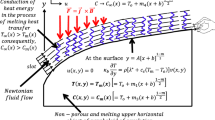Abstract
This paper is concerned with the double diffusive convection due to the melting of an ice plate into a calcium chloride aqueous solution inside a rectangular cavity. It is mainly considered the effect of the cavity inclination θ on the melting rate and the mean melting Nusselt- and Sherwood-numbers, experimentally as well as numerically. The ice plate melts spontaneously with decreasing temperature at the melting front even if initially there does not exist a temperature difference between the ice and the liquid. The concentration- and temperature-gradients near the melting front induce double diffusive convection in the liquid, which will affect the melting rate. Experiments reveal that the mean melting mass increases monotonically with increasing cavity inclination. The numerical analysis based on the laminar assumption predicts well the melting mass in the range of θ=0–90°, however, under-predicts the melting mass in the range of θ=90–180° as compared with the experimental results.










Similar content being viewed by others
Abbreviations
- a :
-
thermal diffusivity, m2/s
- c :
-
specific heat, kJ/(kg K)
- D :
-
mass diffusion coefficient, m2/s
- g :
-
acceleration gravity, m/s2
- h f :
-
latent heat of melting ice, kJ/kg
- Le:
-
Lewis number (=a/D)
- L x , L y , L z :
-
liquid layer dimension in the directions of x, y and z, mm (see Fig. 3)
- C :
-
solvent (CaCl2)concentration, kg/kg or wt%
- 1−C:
-
water (H2O) concentration, kg/kg or wt%
- C F :
-
melting front concentration, kg/kg or wt%
- \(\dot m\) :
-
melting rate (melting mass per unit time and area), kg/(m2 s)
- \(\dot m_{\text{m}} \) :
-
mean melting rate defined by Eq. (10), kg/(m2 s)
- M :
-
transient mean melting mass, kg/m2
- Nu:
- p :
-
pressure, Pa
- q ice :
-
heat flux consumed for ice melting \(( = q_{\text{L}} + q_{\text{S}} = h_f \dot m_{\text{m}} ),\) kJ/m2 s
- q L :
-
heat flux towards the melting front from liquid region, kJ/m2 s
- q S :
-
heat flux towards the melting front from ice plate region, kJ/m2 s
- RaC:
-
concentration Rayleigh number (=gβCL_x3 (CFmean - C_Lymean)/aν
- t :
-
Time, s
- T :
-
temperature, °C or K
- T 1 :
-
center temperature in the ice plate, °C or K (see Fig. 3)
- T 2,3,4 :
-
temperatures in the liquid, °C or K (see Fig. 3)
- T F :
-
temperature at the melting front, °C or K (see Fig. 3)
- u :
-
x-component velocity, m/s
- v :
-
y-component velocity, m/s
- V :
-
velocity vector composed of u, v and w, m/s
- w :
-
z-component velocity, m/s
- ΔyF:
-
the mesh size attached on the melting front, mm
- α:
-
mean heat transfer coefficient, kJ/(m2 s K)
- βC:
-
concentration expansion coefficient, 1/(kg/kg)
- βT:
-
temperature expansion coefficient, 1/K
- δ:
-
ice plate thickness (=20 mm)
- θ:
-
cavity inclination angle, °
- λ:
-
thermal conductivity, kJ/(m s K)
- μ:
-
viscosity, kg/(m s)
- ν:
-
kinematic viscosity, m2/s
- ρ:
-
density, kg/m3
- 1:
-
center in the ice plate
- F:
-
melting front
- i:
-
initial
- ice:
-
see Eqs. 8 and 8a
- L:
-
liquid
- L y :
-
bottom in the liquid
- mean:
-
arithmetic mean
- mix:
-
mixture (aqueous solution)
- r:
-
reference (initial value)
- S:
-
ice plate
References
Beckermann C, Viskanta R (1988) Double-diffusive convection due to melting. Int J Heat Mass Transfer 31:2077–2089
Schutz W, Beer H (1992) Melting of ice in pure and saline water inside a square cavity. Chem Eng Processing 21:311–319
Mergui S, Geoffroy S, Benard C (2002) Ice block melting into a binary solution: coupling of the interfacial equilibrium and the flow structures. ASME J Heat Transfer 124:1147–1157
Sugawara M, Fujita T (1997) Melting of an ice layer with double effect of temperature and concentration (2nd report, development of numerical prediction with flow visualization). Trans JSME (Ser B) 63:2784–2792
Sugawara M, Hataya H, Tago M, Fujita T (2000) Three-dimensional temperature and concentration combined convection due to the melting of a horizontal ice plate from below. Trans JSME (Ser B) 66:1470–1478
Sugawara M, Irvine TF (2000) The effect of concentration gradient on the melting of a horizontal ice plate from above. Int J Heat Mass Transfer 43:1591–1601
Sugawara M, Irvine TF, Tago M (2003) Heat and mass transfer characteristics of a temperature and concentration combined convection due to a vertical ice plate melting. ASME J Heat Transfer 125:39–47
Hand Book of Air Conditioning System Design (part 4) (1965) McGraw-Hill Book Company, pp 32–35
Carslaw HS, Jaeger JC (1959) Conduction of heat in solids, 2nd edn. Clarendon Press, Oxford, pp 284
Eckert ERG, Drake RM (1972) Analysis of heat and mass transfer, McGraw-Hill Book Company, pp 718–719
Patankar SV (1980) Numerical heat transfer and fluid flow. Hemisphere Publishing Company
Dropkin D, Somerscales E (1965) Heat transfer by natural convection in liquids confined by two parallel plates which are inclined at various angles with respect to the horizontal. ASME J Heat Transfer 87:77–84
Mergui S, Gobin D (2000) Transient double diffusive convection in a vertical enclosure with asymmetrical boundary conditions. ASME J Heat Transfer 122:598–602
Acknowledgements
The authors wish to acknowledge support for this study by the technical official T. Fujita, K. Katoh and the undergraduate student S. Suzuki
Author information
Authors and Affiliations
Corresponding author
Rights and permissions
About this article
Cite this article
Sugawara, M., Ishikura, T. & Beer, H. Effect of cavity inclination on a temperature and concentration controlled double diffusive convection at ice plate melting. Heat Mass Transfer 41, 432–441 (2005). https://doi.org/10.1007/s00231-004-0557-x
Received:
Published:
Issue Date:
DOI: https://doi.org/10.1007/s00231-004-0557-x




